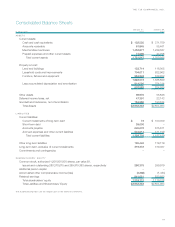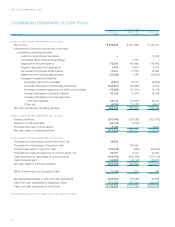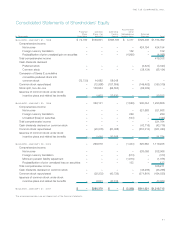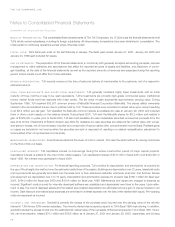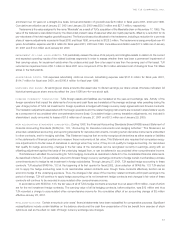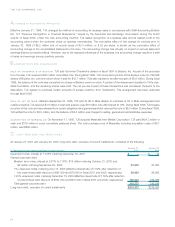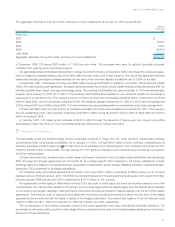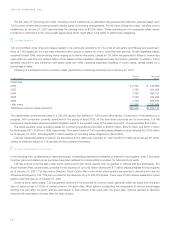TJ Maxx 2000 Annual Report Download - page 6
Download and view the complete annual report
Please find page 6 of the 2000 TJ Maxx annual report below. You can navigate through the pages in the report by either clicking on the pages listed below, or by using the keyword search tool below to find specific information within the annual report.
Notes to Consolidated Financial Statements
SUMMARY OF ACCOUNTING POLICIES
BASIS OF PRESENTATION: The consolidated financial statements of The TJX Companies, Inc. (TJX) include the financial statements of all
TJX’s wholly owned subsidiaries, including its foreign subsidiaries. All intercompany transactions have been eliminated in consolidation. The
notes pertain to continuing operations except where otherwise noted.
FISCAL YEAR: TJX’s fiscal year ends on the last Saturday in January. The fiscal years ended January 27, 2001, January 29, 2000 and
January 30, 1999 each included 52 weeks.
USE OF ESTIMATES: The preparation of the financial statements, in conformity with generally accepted accounting principles, requires
management to make estimates and assumptions that affect the reported amounts of assets and liabilities, and disclosure of contin-
gent liabilities, at the date of the financial statements as well as the reported amounts of revenues and expenses during the reporting
period. Actual results could differ from those estimates.
REVENUE RECOGNITION: TJX records revenue at the time of sale and delivery of merchandise to the customer, net of a reserve for
estimated returns.
CASH, CASH EQUIVALENTS AND SHORT–TERM INVESTMENTS: TJX generally considers highly liquid investments with an initial
maturity of three months or less to be cash equivalents. TJX’s investments are primarily high–grade commercial paper, institutional
money market funds and time deposits with major banks. The fair value of cash equivalents approximates carrying value. During
September 1999, TJX received 693,537 common shares of Manulife Financial Corporation (Manulife). The shares reflect ownership
interest in the demutualized insurer due to policies held by TJX. These securities were recorded at market value upon receipt resulting
in an $8.5 million pre–tax gain. TJX classified the Manulife common shares as available–for–sale at January 29, 2000 and included
them in other current assets on the balance sheets. During fiscal 2001, TJX sold the Manulife shares for $9.2 million and realized a
gain of $722,000. In years prior to fiscal 2000, TJX also held available–for–sale marketable securities received as proceeds from the
sale of its former Chadwick’s of Boston division (see Note B). Available–for–sale securities are stated at fair market value with unreal-
ized gains or losses, net of income taxes, included as a component of accumulated other comprehensive income (loss). Realized gains
or losses are included in net income when the securities are sold or disposed of, resulting in a related reclassification adjustment to
accumulated other comprehensive income (loss).
MERCHANDISE INVENTORIES: Inventories are stated at the lower of cost or market. TJX uses the retail method for valuing inventories
on the first–in first–out basis.
CAPITALIZED INTEREST: TJX capitalizes interest on borrowings during the active construction period of major capital projects.
Capitalized interest is added to the cost of the related assets. TJX capitalized interest of $311,000 in fiscal 2001 and $483,000 in
fiscal 1999. No interest was capitalized in fiscal 2000.
DEPRECIATION AND AMORTIZATION: For financial reporting purposes, TJX provides for depreciation and amortization of property by
the use of the straight–line method over the estimated useful lives of the assets. Buildings are depreciated over 33 years, leasehold costs
and improvements are generally amortized over the lease term or their estimated useful life, whichever is shorter, and furniture, fixtures
and equipment are depreciated over 3 to 10 years. Depreciation and amortization expense for property was $169.1 million for fiscal year
2001, $154.2 million for fiscal year 2000 and $130.4 million for fiscal year 1999. Maintenance and repairs are charged to expense as
incurred. Significant costs incurred for internally developed software are capitalized and depreciated over three to five years. Upon retire-
ment or sale, the cost of disposed assets and the related accumulated depreciation are eliminated and any gain or loss is included in net
income. Debt discount and related issue expenses are amortized to interest expense over the lives of the related debt issues. Pre–opening
costs are expensed as incurred.
GOODWILL AND TRADENAME: Goodwill is primarily the excess of the purchase price incurred over the carrying value of the minority
interest in TJX’s former 83%–owned subsidiary. The minority interest was acquired pursuant to TJX’s fiscal 1990 restructuring. In addition,
goodwill includes the excess of cost over the estimated fair market value of the net assets of Winners acquired by TJX in fiscal 1991. Good-
will, net of amortization, totaled $74.1 million and $76.8 million as of January 27, 2001 and January 29, 2000, respectively, and is being
THE TJX COMPANIES, INC.
22



